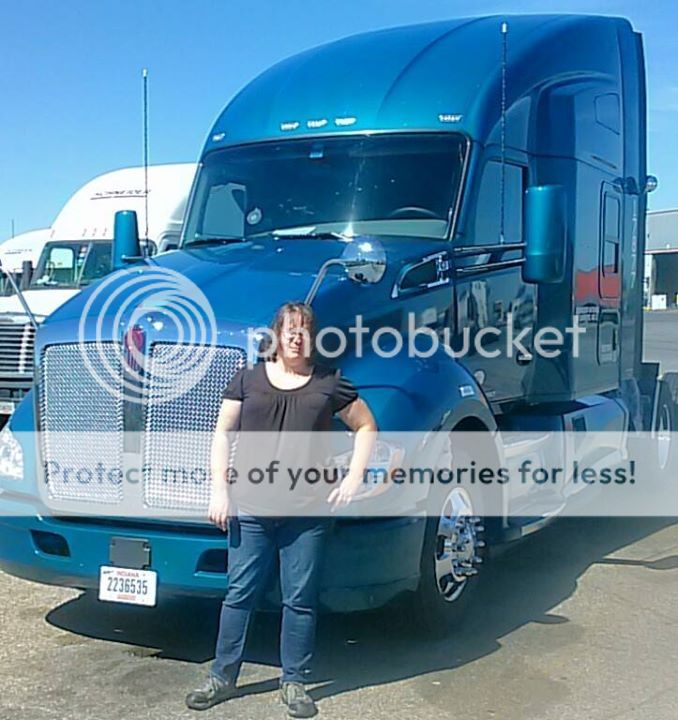Trip Planning, Please Help.
Topic 2446 | Page 1
Joe, this is a fantastic question. Here's my method, it has worked for me always!
My lucky number is 2 1/2 hours.
Why? A customer is only supposed to take 2 hours max and anything over that is not your fault. I like to guess that I'll receive my bills back in 2 hours, and by the time I sweep the trailer, do paperwork and macroes - it'll be 30 minutes later. Yeah you'll get absolutely screwed sometimes, but will it go against you? No. The customer took way too long, it's on them.
Experience is a great tool here. When you go to shippers/receivers a few different times you'll start to remember their performance.
For example, I know that if I'm delivering to a walmart D/C then I will take the rest of the day off because they always take an arm and a leg + 9 months and 4 days. But if I'm delivering to a small place like the Martin Brower in Manassas, VA then I will set my PTA for an hour later because I know from experience that they are lightning quick.
So to sum it up, try to always remember every place you've been and make a judgement call of when to set it based on their previous performance. Otherwise, set it 2 1/2 hours after the appointment time. Sometimes you'll be late for a pickup but being late for a pickup isn't really anything to get angry about - it's the deliveries that matter in the end. And besides, if you're late for your next pickup then you have an excuse. This has worked like a charm for me and I do believe the 2 1/2 is the perfect number.
Very curious to see how others set their PTA.
PTA means projected time of availability to those who don't know.
Shipper:
The customer who is shipping the freight. This is where the driver will pick up a load and then deliver it to the receiver or consignee.
HOS:
Hours Of Service
HOS refers to the logbook hours of service regulations.
I agree with Daniel. I arrive @ the destination no later than 30 minutes early, and allow 2 hours from the appointment time for unloading. Generally, any loading/unloading over two hours is considered for detention pay. As Daniel stated, you will learn quickly which places take forever. I learned that it will be any company that takes the pallets and breaks them down, counts them, and restacks them. If you have an overage/shortage/damage then it takes even longer. If I am unsure if it is a live load or drop/hook, I am always able to send a message in and find out. Your company will know which one it is so don't be afraid to ask because it will help with trip planning.

What a great question, and one I am very interested to read about. I finished with my trainer yesterday and if all goes well will be testing out tomorrow and getting my truck.
I spent about 22 days in the truck (some home time mixed in) with my trainer. Not once did he do any real trip planning. It was basically drive till we get there or get too tired then try to find a place to sleep. On my own this is not the way I plan to run. I want to plan my days out the best I can and make adjustments when needed.
Any tips on trip planning over and above time allowed at loading docks would be greatly appreciated.
Woody

This is something I have learned. With the larger companies, they 'usually' have bigger yards that are better organized. So I don't plan as much time at them. No more than an hour.
Then there are others, that even though they insist you show up exactly on time (don't be more than 10 minutes early, ticks them off) and then make you wait for four hours for you load.
As you spend more and more time out there, you will learn more of how different shippers and consignees behave. There are a couple that I go into because for some reason I can get the paperwork faster than my dh. There are others where I would stand around for an hour or so before they would even acknowledge my presence.
I wish you luck out there and I hope that you stay safe.
Consignee:
The customer the freight is being delivered to. Also referred to as "the receiver". The shipper is the customer that is shipping the goods, the consignee is the customer receiving the goods.
Shipper:
The customer who is shipping the freight. This is where the driver will pick up a load and then deliver it to the receiver or consignee.

When I was pulling a reefer , the rule of thumb I used was (unless directions said otherwise), 1 hour before appointment time & 2 hours for load/unload. Then if you needed to have trailer washed out, it would take what it took (how close is a washout, how long a waiting line, etc). Once that was taken care of, then you would be able to set your PTA.
Of course if it took longer to load/unload, then that was detention time in addition to the time already allotted for the load/unload.
So to sum it all up, 3 hours (1 hour before, 2 for load/unload) plus possible detention (and that varies). So no way to have a cut/dried answer to the question, it all depends on shipper/receiver, day of the week, time of day, etc.
Sad part of this whole thing is, once you start your 14 hour clock, unless you do split sleeper berth , no way to stop it.
Ernie
Shipper:
The customer who is shipping the freight. This is where the driver will pick up a load and then deliver it to the receiver or consignee.
Sleeper Berth:
The portion of the tractor behind the seats which acts as the "living space" for the driver. It generally contains a bed (or bunk beds), cabinets, lights, temperature control knobs, and 12 volt plugs for power.
Reefer:
A refrigerated trailer.

Bigger companies are more organized. 
I am sorry, I don't mean to laugh. But let me tell you about one of my recent loads.
It was a load of tire. Goodyear. A huge company right?
I couldn't make the drop time. Pickup was no issue, so I requested a different drop. About an hour later I got a message saying my delivery window was opened and the time set back.
It was now to be delivered at 0300 instead of 1900 the evening before.
I arrive at 0300. They refuse the load. It was suppose to be there by 1900 yesterday. 
The guard gets on the phone with the receiver. I get on the Qualcomm with my DM. 4 1/2 hours later they decide they will keep the load, but they can't unload it now, just park it and take an empty.
And bigger companies are faster? I will debate that. While I was waiting, one of the posters I read, Driver's Allow at least 6 hours to be loaded or unloaded while at Goodyear XXXXX.
6 HOURS??????
Now forgive me, but that is taking things just a little bit too far.
And detention pay for my company doesn't start till after 4 hours. But even then there is a catch. If it is already known that there is a long load/unload time, they don't pay detention. They only pay if it is unforeseen. A mistake by the receiver/shipper.
What a lifestyle we have chosen.
There are not many benefits to being an O/O. But I can see that as being one. If our O/O don't want to take a load, they don't have to. And they don't have to give a reason why.
Why on earth would anyone choose to take a load knowing you will wait for 6 hours right off the bat????
Keep it safe out here, the life you save might be your own. Joe S.
Shipper:
The customer who is shipping the freight. This is where the driver will pick up a load and then deliver it to the receiver or consignee.
Qualcomm:
Omnitracs (a.k.a. Qualcomm) is a satellite-based messaging system with built-in GPS capabilities built by Qualcomm. It has a small computer screen and keyboard and is tied into the truck’s computer. It allows trucking companies to track where the driver is at, monitor the truck, and send and receive messages with the driver – similar to email.Dm:
Dispatcher, Fleet Manager, Driver Manager
The primary person a driver communicates with at his/her company. A dispatcher can play many roles, depending on the company's structure. Dispatchers may assign freight, file requests for home time, relay messages between the driver and management, inform customer service of any delays, change appointment times, and report information to the load planners.HOS:
Hours Of Service
HOS refers to the logbook hours of service regulations.OWI:
Operating While Intoxicated
OOS:
When a violation by either a driver or company is confirmed, an out-of-service order removes either the driver or the vehicle from the roadway until the violation is corrected.
Joe, Don't you love this stuff! We get into some crazy situations don't we? Now you can start understanding why there's so many cry-babies in this business.
Here's a tip that I don't know if you'll like or not but it helps me keep the rubber rolling. I have a regular customer that I pick up at in Connecticut and it always takes about six hours to get loaded there. After just a few times of enduring this frustration I came up with my own solution. Do you remember what happens to your clock after you've been on the sleeper line for eight hours? Well, let me explain it for anyone who might be reading this also. Your driving time gets extended to what it was when you started that eight hour break. As soon as I get to the shipper I put myself on the sleeper berth and stay there until I'm loaded and ready to go, and then I'll sit in their lot (or if I have to leave I've got a place right across the street that I can park at) until eight hours has gone by and then voila! - if I only drove for an hour to get there then now I've got ten legal hours to drive if I want to. I'm certainly not tired, I haven't done anything all day but rest.
You've just got to out smart the system and be willing to put in some long days sometimes. This is the stuff that will put you ahead of the pack and make you a valuable go to guy for your dispatcher.
Keep it safe out there Joe, the life you save might be able to give you some truck driving tips someday!
Shipper:
The customer who is shipping the freight. This is where the driver will pick up a load and then deliver it to the receiver or consignee.
Sleeper Berth:
The portion of the tractor behind the seats which acts as the "living space" for the driver. It generally contains a bed (or bunk beds), cabinets, lights, temperature control knobs, and 12 volt plugs for power.
Dispatcher:
Dispatcher, Fleet Manager, Driver Manager
The primary person a driver communicates with at his/her company. A dispatcher can play many roles, depending on the company's structure. Dispatchers may assign freight, file requests for home time, relay messages between the driver and management, inform customer service of any delays, change appointment times, and report information to the load planners.Joe, I failed to mention that I always try to plan my trip into this shipper immediately following a ten hour break. That's how the magic works. It doesn't do me much good if I'm only going to get two hours back.
Shipper:
The customer who is shipping the freight. This is where the driver will pick up a load and then deliver it to the receiver or consignee.
OWI:
Operating While Intoxicated
Joe, Don't you love this stuff! We get into some crazy situations don't we? Now you can start understanding why there's so many cry-babies in this business.
Here's a tip that I don't know if you'll like or not but it helps me keep the rubber rolling. I have a regular customer that I pick up at in Connecticut and it always takes about six hours to get loaded there. After just a few times of enduring this frustration I came up with my own solution. Do you remember what happens to your clock after you've been on the sleeper line for eight hours? Well, let me explain it for anyone who might be reading this also. Your driving time gets extended to what it was when you started that eight hour break. As soon as I get to the shipper I put myself on the sleeper berth and stay there until I'm loaded and ready to go, and then I'll sit in their lot (or if I have to leave I've got a place right across the street that I can park at) until eight hours has gone by and then voila! - if I only drove for an hour to get there then now I've got ten legal hours to drive if I want to. I'm certainly not tired, I haven't done anything all day but rest.
You've just got to out smart the system and be willing to put in some long days sometimes. This is the stuff that will put you ahead of the pack and make you a valuable go to guy for your dispatcher.
Keep it safe out there Joe, the life you save might be able to give you some truck driving tips someday!
I do that all the time 
Shipper:
The customer who is shipping the freight. This is where the driver will pick up a load and then deliver it to the receiver or consignee.
Sleeper Berth:
The portion of the tractor behind the seats which acts as the "living space" for the driver. It generally contains a bed (or bunk beds), cabinets, lights, temperature control knobs, and 12 volt plugs for power.
Dispatcher:
Dispatcher, Fleet Manager, Driver Manager
The primary person a driver communicates with at his/her company. A dispatcher can play many roles, depending on the company's structure. Dispatchers may assign freight, file requests for home time, relay messages between the driver and management, inform customer service of any delays, change appointment times, and report information to the load planners.New Reply:
New! Check out our help videos for a better understanding of our forum features

















Preview:
This topic has the following tags:
Life On The Road Logbook Questions







 TT On Facebook
TT On Facebook
I have a question that I hope many of you chime in on.
Due to my last job, I don't have much trouble with trip planning as far as getting from point A to point B.
I am even learning how to fit the 14 hour rule into the picture. We didn't have that problem with the bus industry. The 14 hour rule might as well be nonexistent with the bus industry.
In a bus, every time you stop, your 14 hour clock stops. Eating, waiting on customers, etc. The only time it keeps running is if you are loading or unloading luggage. But anyway.
Planning from point A to B is good. Even the 14 hour rule, I am getting used to.
What is kicking my arse is how much time to allow for loading and unloading.
There have been times where I arrive and find out it is a drop and hook (we are not always told, hardly ever actually) and it has taken maybe 30 to 45 minutes. Other times it was suppose to be a quick in and out and it takes over 4 hours.
How in the heck to you put that into planning??
I am about to the point of adding 3 hours to every trip I am given on each end. I know that at times, that won't be enough, and other times it will be too much. But in the long run, I think it will work out to my benefit. At least I won't, most times, be looking for a safe haven with only minutes to go on my clock.
What is your rule of thumb to trip planning to allow for loading and unloading?
Keep it safe out here, the life you save might be your own. Joe S
Drop And Hook:
Drop and hook means the driver will drop one trailer and hook to another one.
In order to speed up the pickup and delivery process a driver may be instructed to drop their empty trailer and hook to one that is already loaded, or drop their loaded trailer and hook to one that is already empty. That way the driver will not have to wait for a trailer to be loaded or unloaded.